Description
Many products have not yet been launched, please contact us for more products
If the product model does not match the displayed image, the model shall prevail. Please contact us for specific product images, and we will arrange for photos to be taken in the warehouse for confirmation
We have 16 shared warehouses worldwide, so sometimes it may take several hours to accurately return to you. We apologize for any inconvenience caused. Of course, we will respond to your concerns as soon as possible.
PR6423/10R-111+CON031 Other names:
Epro displacement sensor PR6423/10R-111+CON031
PR6423/10R-111+CON031 Eddy Current Signal Converter
Emerson eddy current displacement sensor PR6423/10R-111+CON031
PR6423/10R-111+CON031 is an eddy current sensor system designed for non-contact measurement of static and dynamic displacement, such as axial and radial shaft displacement and bearing wear. This system is particularly suitable for critical turbomachinery applications, including steam, gas, and hydro turbines, compressors, and gearboxes. The system consists of two main components: PR6423 sensor and CON021 signal converter. 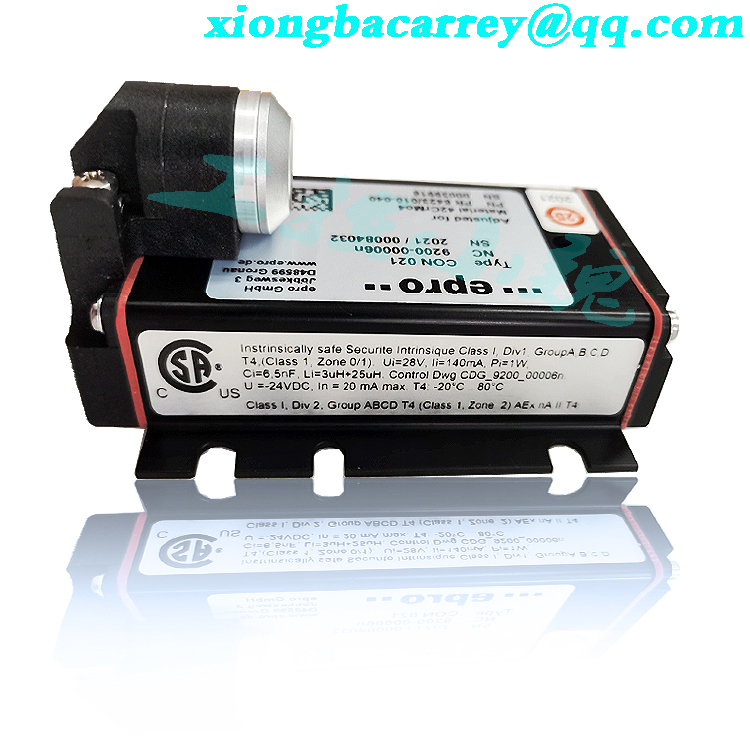
Basic Overview
Model: PR6423/10R-111+CON031
Manufacturer: Emerson EPRO
Type: Eddy current sensor
Main features:
Sensor (PR6423): PR6423 is an 8mm eddy current sensor that can detect vibrations on the surface of rotating mechanical shafts. Its tip size is small and can be installed in areas with limited space around the shaft.
Signal Converter (CON021): The CON021 converter amplifies weak signals from sensors and converts them into standard voltage outputs, typically 4-20mA or 0-10V, for transmission to monitoring and control systems.
Application: Highly suitable for precise vibration monitoring of critical industrial machinery, including steam, gas, and hydro turbines, compressors, pumps, and fans.
Compatibility: This system is compatible with various control systems and has specific output voltage ranges and scaling options, depending on the model and application.
Environmental Applicability: Designed to withstand harsh industrial environments, operating temperatures typically range from -40 ° C to+125 ° C.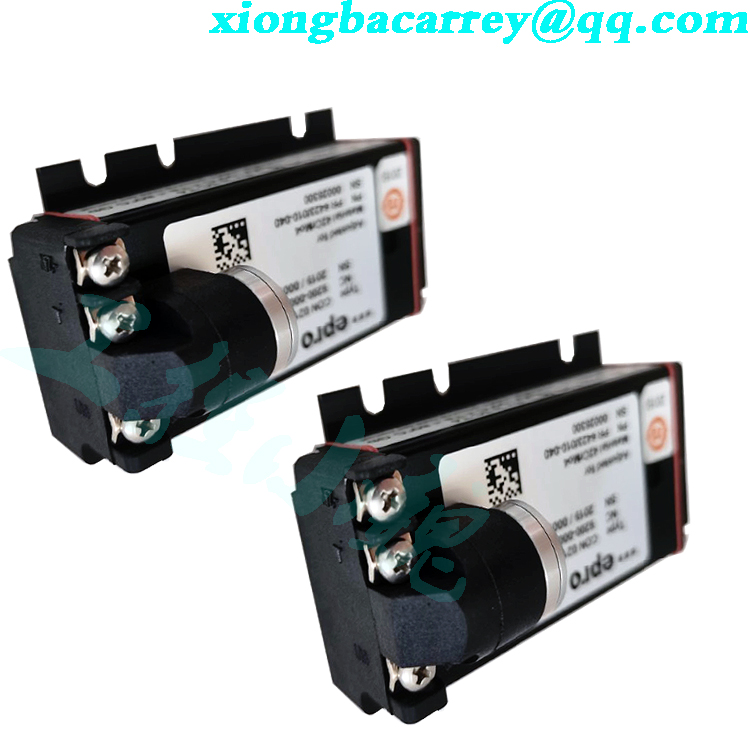
Working principle
Eddy current sensors work based on the eddy current effect, which means that when a metal conductor is placed in a changing magnetic field, an induced current is generated inside the metal body, forming self assembling eddy current lines. The sensor probe (eddy current probe) is a flat coil fixed on the frame. When the probe approaches the object being measured, an induced current is generated on the surface of the object, resulting in a reverse electromagnetic field. Sensors determine the distance between the object being measured based on the strength of the reverse electromagnetic field.
Main characteristics and parameters
Sensitivity and linearity:
Sensitivity: 8 V/mm (203.2 mV/mil)
Linearity: ≤± 1%
Measurement range:
Static range: ± 1 millimeter (0.040 inches)
Dynamic range: 0 to 500 μ m (0 to 0.020 “)
Air gap (center) nominal value: approximately 1.5 millimeters (0.06 inches)
Long term drift:<0.3%
Target material/surface material: ferromagnetic steel (42 Cr Mo4 standard)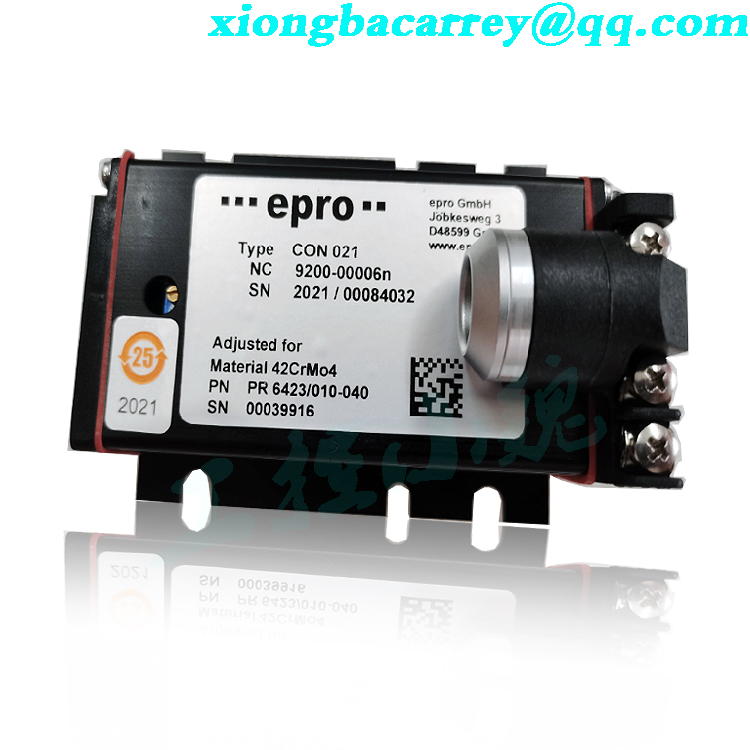
Maximum surface velocity: 2500 m/s (98425 ips)
Shaft diameter: ≥ 25 mm
Working temperature range:
Sensors and cables: -35 to 200 ° C (-31 to 392 ° F)
Connector: -35 to 150 ° C (-31 to 302 ° F)
Temperature error:<2%/100 ° K (compliant with API standards)
Pressure resistance of sensor head: 10000 hPa (145 psi)
Shock and vibration: 5g@60 Hz@25 °C(77°F)
Material:
Sleeve: Stainless steel
Cable: Polytetrafluoroethylene
Weight: Sensor and 1M cable (unarmored) approximately 100 grams (3.53 ounces)
Safety Certification: Intrinsic Safety (iA), ATEX/IEC Ex/CSA Certification, Spark Free (nA)
Integration and usage:
Compatibility: This system is compatible with various control systems and can be seamlessly integrated into existing industrial settings.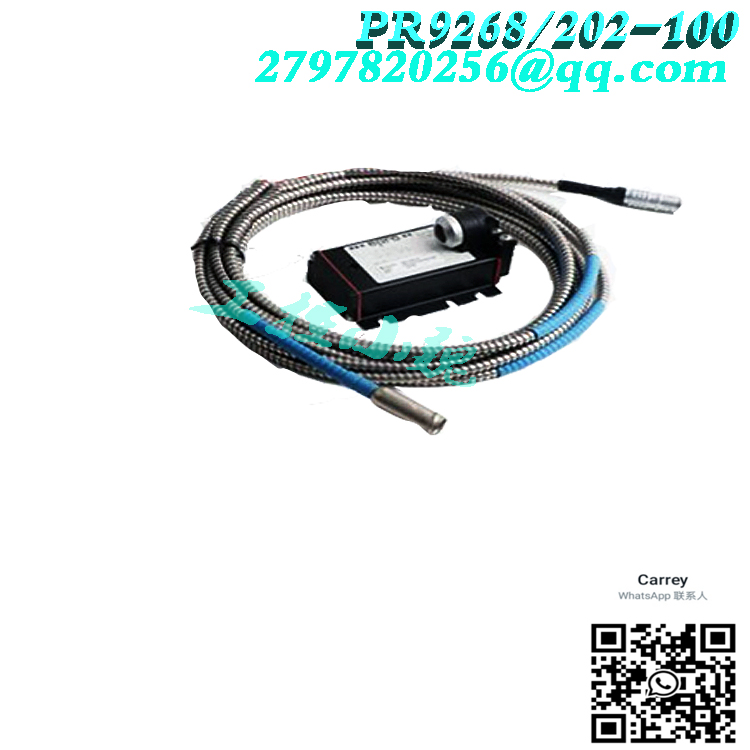
Maintenance and Diagnosis: By providing precise measurements of shaft displacement and bearing wear, this system facilitates predictive maintenance and diagnosis, helping to prevent unexpected shutdowns.
Application scenarios
Due to its high precision, high sensitivity, and wide range of applications, this sensor is often used to monitor the vibration of mechanical equipment, such as shaft vibration monitoring of large rotating machinery such as steam turbines and generators, as well as displacement measurement in industrial automation systems.
Application:
Accurate vibration monitoring: Very suitable for monitoring critical industrial machinery, including steam, gas, and hydraulic turbines, compressors, pumps, and fans.
Non contact measurement: Provides non-contact measurement function to reduce the risk of sensor and monitored mechanical damage.
Wide working range: typically operates within a temperature range of -40 ° C to+125 ° C, suitable for harsh industrial environments.
Installation and Debugging
When installing sensors, a rigid vibration free bracket with installation threads should be used, and the threads should be clean and run smoothly. When adjusting the measurement target and sensor head, it is necessary to fix the sensor with a fixed nut and pay attention to the maximum torque requirement of the fixed nut. In addition, sensors need to be adjusted and calibrated appropriately according to specific application scenarios and measurement requirements.
Summary
PR6423/10R-111+CON031 eddy current sensor is a high-performance and high-precision sensor with a wide range of applications and reliable measurement performance. Its working principle based on eddy current effect and advanced structural design make the sensor play an important role in mechanical equipment vibration monitoring and industrial automation systems.
The PR6423/10R-111+CON031 eddy current sensor system provides a reliable solution for precise vibration monitoring in industrial environments. The combination of its non-contact measurement function and the amplification and conversion function of the CON021 signal converter makes it an important tool for maintaining critical mechanical health and efficiency. Whether installed in steam turbines, gas compressors, or other high-value assets, this system ensures continuous monitoring and early detection of anomalies, thereby contributing to safer and more reliable operation.
All products on this website are special products, and market prices have been fluctuating,
Please refer to the customer service quotation for details, as the product is new and the price is not genuine,
Please confirm the model, product, price, and other detailed information with customer service before placing an order. The website has been used,
The new one is for sale, please contact customer service for further communication.
Model recommendation:
L0115012 L0115032
MMS3125/022-020
PR6423/00R-010 CON021
PR6423/00R-010
PR6423/015-130 9200-02335N
CON021 PR6423/010-010
PR6423/10R-030+CON021
PR6423/103-040 (152-1)
PR6423/003-030
PR6423/002-141
PR6423/10R-030+CON021
PR6423/10R-111+CON031
PR6423/11R-131+CON031
PR6423/013-030+CON021
PR6423/013-030+CON021
MMS3125/022-020
PR6423/00R-010 CON021
PR6423/00R-010
PR6423/015-130 9200-02335N
more……


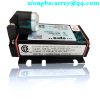
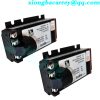
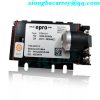
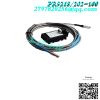

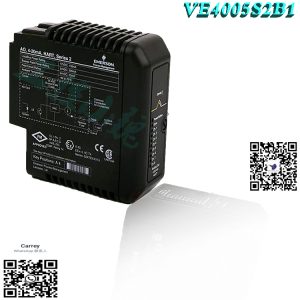
admin –
The EPRO PR6423/10R-111+CON031 sensor probe is a device used to measure shaft vibration, typically used to monitor the status and operation of rotating machinery. It can measure the vibration amplitude, frequency and other parameters of the shaft, and analyze and process them through the control system to achieve the purpose of early warning, fault diagnosis, and preventive maintenance.
The working principle of the shaft vibration sensor probe is mainly based on electromagnetic induction or optical principles. It is usually connected to the shaft of rotating machinery and measured as the shaft rotates. By measuring the magnetic field or optical path changes generated by shaft vibration, sensors can obtain shaft vibration information and convert it into electrical or optical signals for output.
The EPRO PR6423/10R-111+CON031 sensor probe has the characteristics of high sensitivity, high precision, and high reliability, which can accurately measure small changes in shaft vibration and provide reliable monitoring data. It is usually used in conjunction with control systems to achieve real-time monitoring and fault warning of rotating machinery, ensuring the normal operation of equipment and the stability of the production process.
Lorine Keeter –
Youre so cool! I dont suppose Ive read something like this before. So good to search out any individual with some original thoughts on this subject. realy thank you for starting this up. this website is something that’s wanted on the web, somebody with a little bit originality. useful job for bringing one thing new to the web!